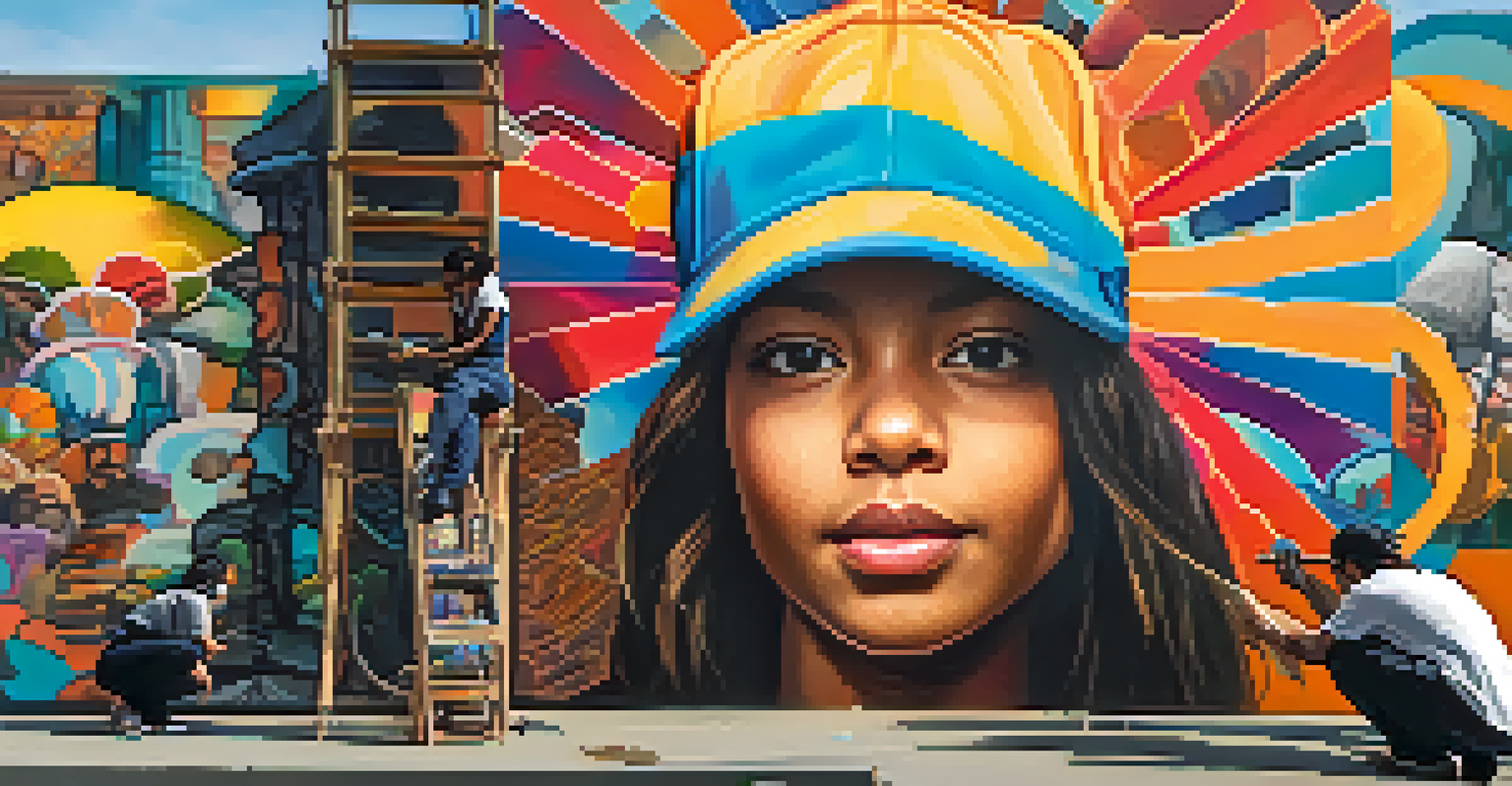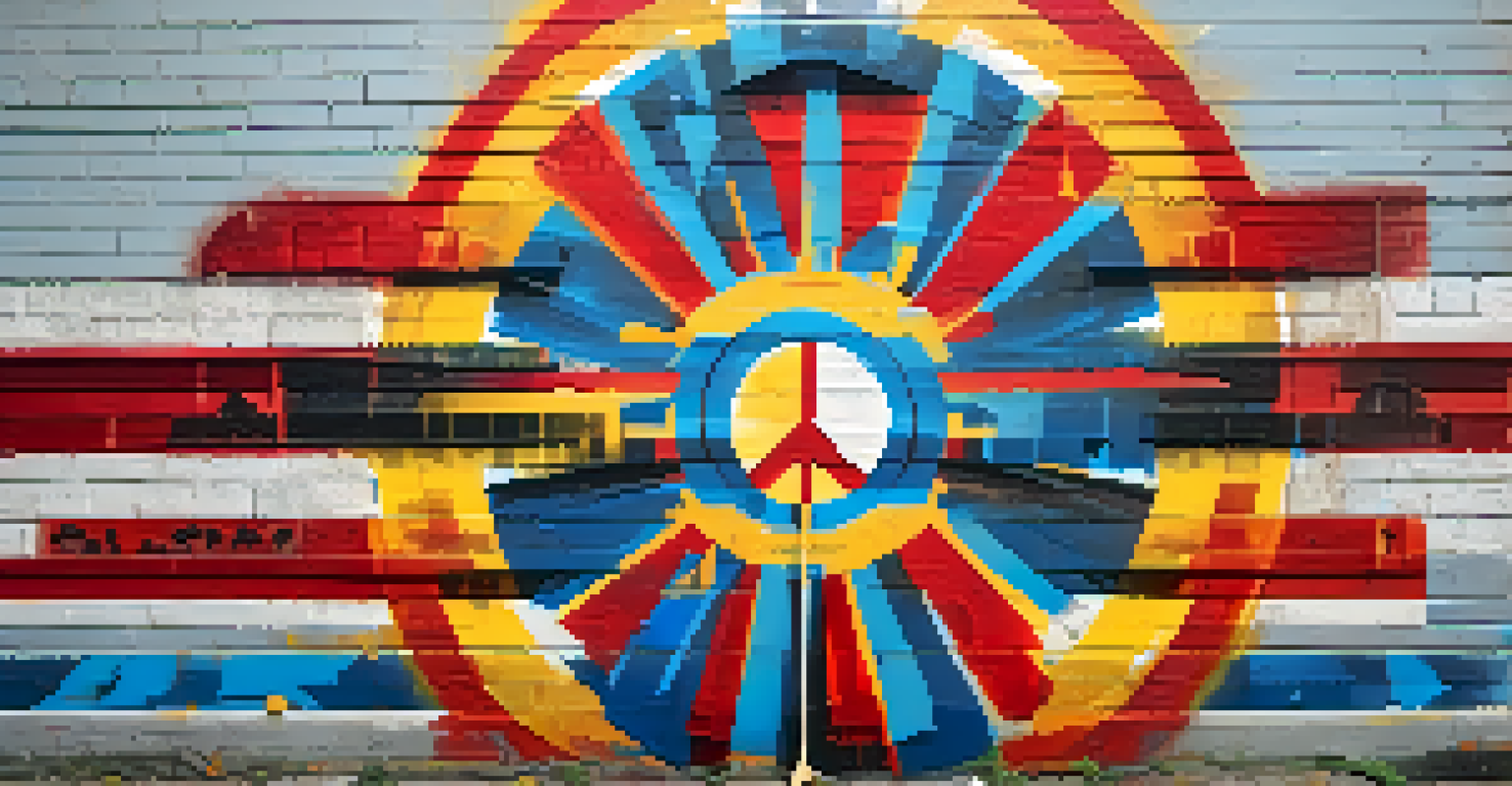Street Art and Globalization: The Voice of the Urban Artist

Understanding Street Art: More Than Just Graffiti
Street art encompasses a wide range of artistic expressions, often created in public spaces. Unlike traditional graffiti, which sometimes conveys a sense of vandalism, street art is often seen as a legitimate form of artistic expression. Artists use walls, streets, and public areas to share messages, provoke thought, and beautify urban landscapes. This art form invites discussion and engages communities, turning everyday environments into vibrant canvases.
Art is the most beautiful of all lies.
The appeal of street art lies in its accessibility—no gallery walls or ticket prices are needed. Anyone walking down the street can experience the creativity and messages conveyed through this medium. It often reflects the culture, struggles, and aspirations of the local community, making it a powerful voice for urban artists. In this way, street art stands as a bridge between the artist and the public, fostering connection and dialogue.
Furthermore, street art often incorporates various styles and techniques, from stencils to murals and wheatpasting. Each style carries its own history and significance, allowing artists to convey their unique perspectives. As urban landscapes evolve, so does street art, continually adapting to reflect the changing dynamics of society and culture.
Globalization and Its Impact on Urban Art
Globalization has dramatically altered the landscape of street art, influencing its themes, styles, and reach. As artists travel and share ideas across borders, they bring different cultural elements into their work, enriching the street art scene. This cross-pollination of creativity allows for new techniques and messages to emerge, making the art form more diverse and relevant to a global audience.

Moreover, the internet plays a crucial role in this globalization process. Social media platforms enable artists to showcase their work to a worldwide audience, leading to increased recognition and opportunities. It’s common for local artists to gain international fame, thanks to online visibility. This, however, raises questions about authenticity and cultural appropriation, as artists navigate the fine line between inspiration and imitation.
Street Art as Community Voice
Street art transforms urban spaces into vibrant canvases, giving voice to local culture and community issues.
While globalization can amplify voices, it can also lead to commercialization, where street art becomes commodified. Some artists may find their work reproduced on various merchandise or used for advertising, which can dilute the original message. This tension between artistic integrity and commercial success is a recurring theme in the world of street art.
Street Art as a Form of Resistance
Throughout history, street art has served as a powerful tool for social and political resistance. Artists often use their work to comment on issues such as inequality, corruption, and human rights abuses. By placing their art in public spaces, they challenge the status quo and provoke conversations that might otherwise be ignored. This rebellious spirit is an integral part of street art's identity.
The role of the artist is to make the revolution irresistible.
For instance, during political unrest, murals and graffiti can become symbols of resistance, rallying communities around a common cause. These works often convey urgent messages that resonate with the public, making art a vehicle for activism. Street artists transform city streets into canvases for political commentary, encouraging dialogue and awareness about pressing issues.
Moreover, street art can also foster unity among marginalized communities. By giving a voice to those who may feel voiceless, artists create a sense of belonging and empowerment. This collective action through art not only inspires change but also strengthens community ties, proving that creativity can spark social movements.
Cultural Exchange: The Role of Street Art in Global Cities
In global cities, street art becomes a symbol of cultural exchange, where diverse backgrounds intersect and influence one another. Artists from different cultures bring their unique perspectives, resulting in a rich tapestry of styles and themes. This melting pot of creativity allows for a deeper understanding and appreciation of various cultural narratives within urban spaces.
As street art proliferates in cities around the world, it often reflects local histories while also incorporating global influences. For example, a mural in New York City might draw inspiration from traditional art forms in Africa or Asia, showcasing the interconnectedness of global cultures. This blending of ideas fosters an environment where creativity knows no boundaries and encourages collaboration among artists.
Globalization Influences Street Art
Globalization and technology have expanded street art's reach and diversity, allowing artists to share and adapt their work across cultures.
Additionally, cultural festivals and events often highlight street art, bringing artists together to share their work and ideas. These gatherings promote dialogue and understanding, reinforcing the idea that art can transcend geographical and cultural barriers. By celebrating street art, cities can strengthen their identities while embracing the global influences that shape them.
The Digital Age: How Technology Shapes Street Art
The rise of technology has transformed the way street artists create, share, and promote their work. Tools such as digital design software and social media platforms have expanded the possibilities for artists, allowing for innovative techniques and broader audiences. For instance, some artists use augmented reality to enhance their murals, creating interactive experiences for viewers.
Social media serves as a vital tool for street artists, enabling them to showcase their work and connect with a global audience. Platforms like Instagram and TikTok allow artists to share their creative process, engage with fans, and collaborate with others. This digital presence can lead to increased visibility, opportunities for commissions, and even gallery exhibitions, further bridging the gap between street art and the mainstream art world.
However, this digital shift also raises concerns about the authenticity of street art. As artists gain fame online, there is a risk that their work could lose its grassroots essence. The challenge lies in maintaining the spirit of street art while embracing the benefits of technology, ensuring that it remains a genuine form of expression.
Commercialization: The Double-Edged Sword of Street Art
The commercialization of street art presents a complex dilemma for artists and the communities they represent. While some artists embrace the opportunities that come with commercial partnerships, such as sponsorships or brand collaborations, others fear that this could compromise their artistic integrity. The line between art and advertising can become blurred, leading to debates about authenticity and purpose.
For example, a mural originally created as a form of protest might later be used in a marketing campaign, stripping it of its original context and meaning. This shift can alienate local communities who see their culture commodified for profit. Artists must navigate these waters carefully, balancing the desire for recognition and financial stability with their commitment to social messages.
Commercialization Challenges Authenticity
The commercialization of street art poses dilemmas for artists, balancing the pursuit of recognition with the preservation of their original messages.
On the flip side, commercial success can provide artists with the resources and platforms needed to amplify their voices. Collaborations with brands can lead to greater visibility and funding for community projects. Ultimately, the challenge lies in finding a balance between commercial appeal and staying true to the core values of street art.
The Future of Street Art in a Globalized World
As globalization continues to shape our world, the future of street art is poised for further evolution. Artists will likely continue to navigate the intersection of local and global influences, creating work that resonates with diverse audiences. This adaptability will ensure that street art remains a dynamic and relevant form of expression in the ever-changing urban landscape.
Moreover, as communities become more interconnected, street art may increasingly reflect global issues such as climate change, migration, and social justice. Artists have a unique ability to address these topics in impactful ways, using their work to inspire action and awareness. By engaging with global challenges, street art can play a vital role in fostering understanding and collaboration across cultures.

Lastly, the ongoing advancements in technology will continue to influence how street art is created and experienced. As new mediums and platforms emerge, artists will find innovative ways to connect with their audiences. The future of street art promises to be a vibrant tapestry of creativity, activism, and cultural dialogue, reinforcing its significance in a globalized world.